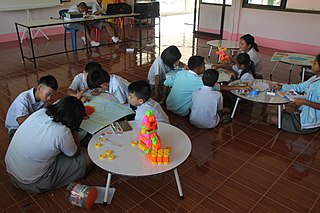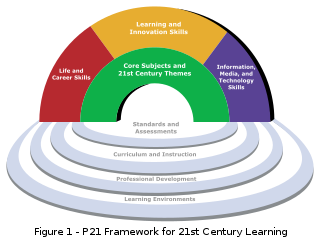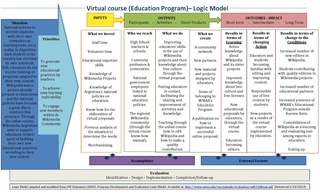Computer-assisted language learning (CALL), known as computer-aided instruction (CAI) in British English and computer-aided language instruction (CALI) in American English, Levy briefly defines it as "the exploration and study of computer applications in language teaching and learning." CALL embraces a wide range of information and communications technology "applications and approaches to teaching and learning foreign languages, ranging from the traditional drill-and-practice programs that characterized CALL in the 1960s and 1970s to more recent manifestations of CALL, such as those utilized virtual learning environment and Web-based distance learning. It also extends to the use of corpora and concordancers, interactive whiteboards, computer-mediated communication (CMC), language learning in virtual worlds, and mobile-assisted language learning (MALL).

Pedagogy, most commonly understood as the approach to teaching, is the theory and practice of learning, and how this process influences, and is influenced by, the social, political, and psychological development of learners. Pedagogy, taken as an academic discipline, is the study of how knowledge and skills are imparted in an educational context, and it considers the interactions that take place during learning. Both the theory and practice of pedagogy vary greatly as they reflect different social, political, and cultural contexts.
Blended learning or hybrid learning, also known as technology-mediated instruction, web-enhanced instruction, or mixed-mode instruction, is an approach to education that combines online educational materials and opportunities for interaction online with physical place-based classroom methods.

Project-based learning is a teaching method that involves a dynamic classroom approach in which it is believed that students acquire a deeper knowledge through active exploration of real-world challenges and problems. Students learn about a subject by working for an extended period of time to investigate and respond to a complex question, challenge, or problem. It is a style of active learning and inquiry-based learning. Project-based learning contrasts with paper-based, rote memorization, or teacher-led instruction that presents established facts or portrays a smooth path to knowledge by instead posing questions, problems, or scenarios.
Clark Aldrich is an American author and practitioner in the field of educational simulations and serious games for education and professional skills.
Technology integration is defined as the use of technology to enhance and support the educational environment. Technology integration in the classroom can also support classroom instruction by creating opportunities for students to complete assignments on the computer rather than with normal pencil and paper. In a larger sense, technology integration can also refer to the use of an integration platform and application programming interface (API) in the management of a school, to integrate disparate SaaS applications, databases, and programs used by an educational institution so that their data can be shared in real-time across all systems on campus, thus supporting students' education by improving data quality and access for faculty and staff.
"Curriculum integration with the use of technology involves the infusion of technology as a tool to enhance the learning in a content area or multidisciplinary setting... Effective technology integration is achieved when students can select technology tools to help them obtain information on time, analyze and synthesize it, and present it professionally to an authentic audience. Technology should become an integral part of how the classroom functions—as accessible as all other classroom tools. The focus in each lesson or unit is the curriculum outcome, not the technology."
Culturally relevant teaching is instruction that takes into account students' cultural differences. Making education culturally relevant is thought to improve academic achievement, but understandings of the construct have developed over time Key characteristics and principles define the term, and research has allowed for the development and sharing of guidelines and associated teaching practices. Although examples of culturally relevant teaching programs exist, implementing it can be challenging.

Digital literacy is an individual's ability to find, evaluate, and communicate information using typing or digital media platforms. It is a combination of both technical and cognitive abilities in using information and communication technologies to create, evaluate, and share information.
Lee S. Shulman is an American educational psychologist and reformer. He has made notable contributions to the study of teaching, assessment of teaching, and the fields of medicine, science, mathematics, and the scholarship of teaching and learning.
Personalized learning, individualized instruction, personal learning environment and direct instruction all refer to efforts to tailor education to meet the different needs of students.

Information and media literacy (IML) enables people to show and make informed judgments as users of information and media, as well as to become skillful creators and producers of information and media messages. IML is a combination of information literacy and media literacy. The transformative nature of IML includes creative works and creating new knowledge; to publish and collaborate responsibly requires ethical, cultural and social understanding.

The term digital native describes a person who has grown up in the information age. The term "digital native" was coined by Marc Prensky, an American writer, speaker and technologist who wrote several articles referencing this subject. This term specifically applied to the generation that grew up in the "digital age," predominantly regarding individuals born after the year 1980, namely Millennials, Generation Z, and Generation Alpha. Individuals from these demographic cohorts can consume digital information quickly and comfortably through electronic devices and platforms such as computers, mobile phones, and social media.

Open education is an educational movement founded on openness, with connections to other educational movements such as critical pedagogy, and with an educational stance which favours widening participation and inclusiveness in society. Open education broadens access to the learning and training traditionally offered through formal education systems and is typically offered through online and distance education. The qualifier "open" refers to the elimination of barriers that can preclude both opportunities and recognition for participation in institution-based learning. One aspect of openness or "opening up" education is the development and adoption of open educational resources in support of open educational practices.
Challenge-based learning (CBL) is a framework for learning while solving real-world Challenges. The framework is collaborative and hands-on, asking all participants to identify Big Ideas, ask good questions, discover and solve Challenges, gain in-depth subject area knowledge, develop 21st-century skills, and share their thoughts with the world.

Open educational practices (OEP) are part of the broader open education landscape, including the openness movement in general. It is a term with multiple layers and dimensions and is often used interchangeably with open pedagogy or open practices. OEP represent teaching and learning techniques that draw upon open and participatory technologies and high-quality open educational resources (OER) in order to facilitate collaborative and flexible learning. Because OEP emerged from the study of OER, there is a strong connection between the two concepts. OEP, for example, often, but not always, involve the application of OER to the teaching and learning process. Open educational practices aim to take the focus beyond building further access to OER and consider how in practice, such resources support education and promote quality and innovation in teaching and learning. The focus in OEP is on reproduction/understanding, connecting information, application, competence, and responsibility rather than the availability of good resources. OEP is a broad concept which can be characterised by a range of collaborative pedagogical practices that include the use, reuse, and creation of OER and that often employ social and participatory technologies for interaction, peer-learning, knowledge creation and sharing, empowerment of learners, and open sharing of teaching practices.

Minerva Project is an educational organization that designs and delivers educational programs through educational and corporate partners globally. Its mission is reforming education through an interdisciplinary curriculum and fully active learning pedagogy delivered on a proprietary learning environment called Forum.
The Digital Visitor and Resident (V&R) model provides a framework to depict how user preference and habit motivates engagement with technology and the web. V&R is commonly described as a continuum, with two modes of online engagement at either end, making a separation between different approaches to engagement. People operating in Visitor mode have a defined goal or task, and select an appropriate online tool to meet their needs as they arise. For example, using a smartphone to search the internet for directions to a local bookstore, thus finding a particular piece of information online and then going offline to complete the task. There will be little in terms of social visibility or trace when online in Visitor mode. People operating in Resident mode are online to connect to, or to be with, other people. For example, posting to the wall in Facebook, tweeting, blogging, or posting comments on blogs. The web supports the projection of their identity and facilitates relationships. In other words, Residents live a percentage of their lives online. Unlike the Visitor mode, there will be online visibility and presence when in Resident mode. It is very common for individuals to engage online in a mixture of Visitor and Resident modes depending on what they are trying to achieve.

21st century skills comprise skills, abilities, and learning dispositions identified as requirements for success in 21st century society and workplaces by educators, business leaders, academics, and governmental agencies. This is part of an international movement focusing on the skills required for students to prepare for workplace success in a rapidly changing, digital society. Many of these skills are associated with deeper learning, which is based on mastering skills such as analytic reasoning, complex problem solving, and teamwork, which differ from traditional academic skills as these are not content knowledge-based.

Digital pedagogy is the study and use of contemporary digital technologies in teaching and learning. Digital pedagogy may be applied to online, hybrid, and face-to-face learning environments. Digital pedagogy also has roots in the theory of constructivism.
Virtual exchange is an instructional approach or practice for language learning. It broadly refers to the "notion of 'connecting' language learners in pedagogically structured interaction and collaboration" through computer-mediated communication for the purpose of improving their language skills, intercultural communicative competence, and digital literacies. Although it proliferated with the advance of the internet and Web 2.0 technologies in the 1990s, its roots can be traced to learning networks pioneered by Célestin Freinet in 1920s and, according to Dooly, even earlier in Jardine's work with collaborative writing at the University of Glasgow at the end of the 17th to the early 18th century.










